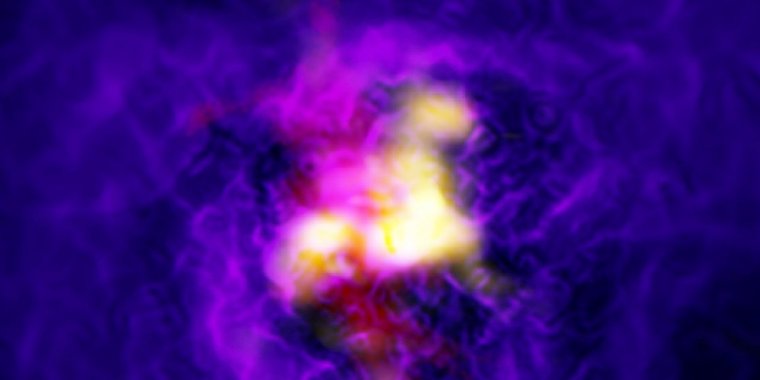| News / Space News |
ALMA and MUSE Detect Galactic Fountain
A mere one billion light-years away in the nearby galaxy cluster known as Abell 2597, there lies a gargantuan galactic fountain. A massive black hole at the heart of a distant galaxy has been observed pumping a vast spout of cold molecular gas into space, which then rains back onto the black hole as an intergalactic deluge.

ALMA and MUSE detect galactic fountain. Image credit: ESO (CC BY 4.0)
The in- and outflow of such a vast cosmic fountain has never before been observed in combination, and has its origin in the innermost 100 000 light-years of the brightest galaxy in the Abell 2597 cluster.
The supermassive black hole at the centre of this giant galaxy acts like a mechanical pump in a fountain.
The team used ALMA to track the position and motion of molecules of carbon monoxide within the nebula. These cold molecules, with temperatures as low as minus 250–260°C, were found to be falling inwards to the black hole.
The team also used data from the MUSE instrument on ESO’s Very Large Telescope to track warmer gas — which is being launched out of the black hole in the form of jets.
Together these two sets of data form a complete picture of the process; cold gas fall towards the black hole, igniting the black hole and causing it to launch fast-moving jets of incandescent plasma into the void. These jets then spout from the black hole in a spectacular galactic fountain.
With no hope of escaping the galaxy’s gravitational clutches, the plasma cools off, slows down, and eventually rains back down on the black hole, where the cycle begins anew.
This unprecedented observation could shed light on the life cycle of galaxies. The team speculates that this process may be not only common, but also essential to understanding galaxy formation.
While the inflow and outflow of cold molecular gas have both previously been detected, this is the first time both have been detected within one system, and hence the first evidence that the two make up part of the same vast process.
Abell 2597 is found in the constellation Aquarius, and is named for its inclusion in the Abell catalogue of rich clusters of galaxies. The catalogue also includes such clusters as the Fornax cluster, the Hercules cluster, and Pandora’s cluster. (ESO)
YOU MAY ALSO LIKE


